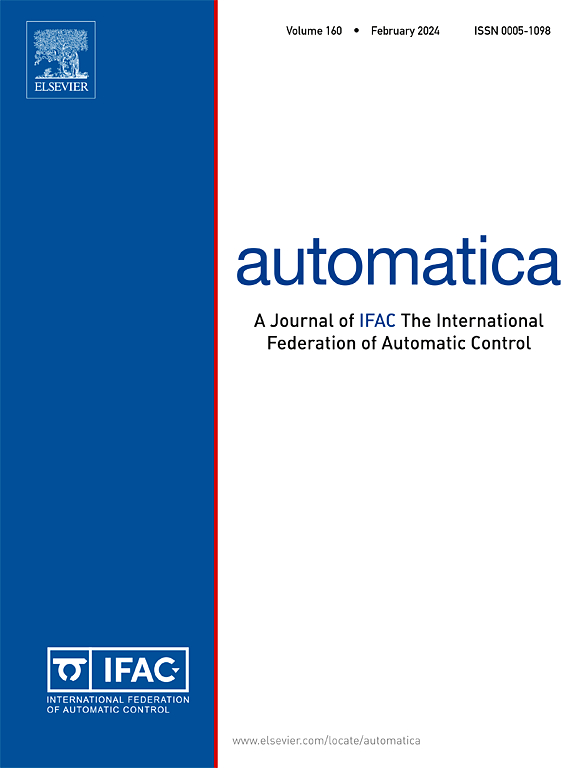Distributed data-driven unknown-input observers
IF 5.9
2区 计算机科学
Q1 AUTOMATION & CONTROL SYSTEMS
引用次数: 0
Abstract
Unknown inputs related to, e.g., sensor aging, modeling errors, or device bias, represent a major concern in wireless sensor networks, as they degrade the state estimation performance. To improve the performance, unknown-input observers (UIOs) have been proposed. Most of the results available to design UIOs are based on explicit system models, which can be difficult or impossible to obtain in real-world applications. Data-driven techniques, on the other hand, have become a viable alternative for the design and analysis of unknown systems using only data. In this context, a novel data-driven distributed unknown-input observer (D-DUIO) for unknown continuous-time linear time-invariant (LTI) systems is developed, which requires solely some data collected offline, without any prior knowledge of the system matrices. In the paper, first, a model-based approach to the design of a DUIO is presented. A sufficient condition for the existence of such a DUIO is recalled, and a new one is proposed, that is prone to a data-driven adaptation. Moving to a data-driven approach, it is shown that under suitable assumptions on the input/output/state data collected from the continuous-time system, it is possible to both claim the existence of a D-DUIO and to derive its matrices in terms of the matrices of pre-collected data. Finally, the efficacy of the D-DUIO is illustrated by means of numerical examples.
分布式数据驱动的未知输入观察者
与传感器老化、建模错误或设备偏差等相关的未知输入是无线传感器网络中的一个主要问题,因为它们会降低状态估计性能。为了提高性能,提出了未知输入观测器(UIOs)。可用于设计ui的大多数结果都基于显式系统模型,这在实际应用程序中可能很难或不可能获得。另一方面,数据驱动技术已经成为仅使用数据设计和分析未知系统的可行替代方案。在这种背景下,针对未知连续时间线性时不变(LTI)系统,开发了一种新的数据驱动的分布式未知输入观测器(D-DUIO),它只需要离线收集一些数据,而不需要任何系统矩阵的先验知识。本文首先提出了一种基于模型的双io设计方法。回顾了这种双io存在的充分条件,并提出了一个易于进行数据驱动适应的新条件。转向数据驱动的方法,表明在对从连续时间系统收集的输入/输出/状态数据的适当假设下,可以声明D-DUIO的存在,并根据预先收集的数据矩阵推导出其矩阵。最后,通过数值算例说明了D-DUIO的有效性。
本文章由计算机程序翻译,如有差异,请以英文原文为准。
求助全文
约1分钟内获得全文
求助全文
来源期刊

Automatica
工程技术-工程:电子与电气
CiteScore
10.70
自引率
7.80%
发文量
617
审稿时长
5 months
期刊介绍:
Automatica is a leading archival publication in the field of systems and control. The field encompasses today a broad set of areas and topics, and is thriving not only within itself but also in terms of its impact on other fields, such as communications, computers, biology, energy and economics. Since its inception in 1963, Automatica has kept abreast with the evolution of the field over the years, and has emerged as a leading publication driving the trends in the field.
After being founded in 1963, Automatica became a journal of the International Federation of Automatic Control (IFAC) in 1969. It features a characteristic blend of theoretical and applied papers of archival, lasting value, reporting cutting edge research results by authors across the globe. It features articles in distinct categories, including regular, brief and survey papers, technical communiqués, correspondence items, as well as reviews on published books of interest to the readership. It occasionally publishes special issues on emerging new topics or established mature topics of interest to a broad audience.
Automatica solicits original high-quality contributions in all the categories listed above, and in all areas of systems and control interpreted in a broad sense and evolving constantly. They may be submitted directly to a subject editor or to the Editor-in-Chief if not sure about the subject area. Editorial procedures in place assure careful, fair, and prompt handling of all submitted articles. Accepted papers appear in the journal in the shortest time feasible given production time constraints.
 求助内容:
求助内容: 应助结果提醒方式:
应助结果提醒方式:


